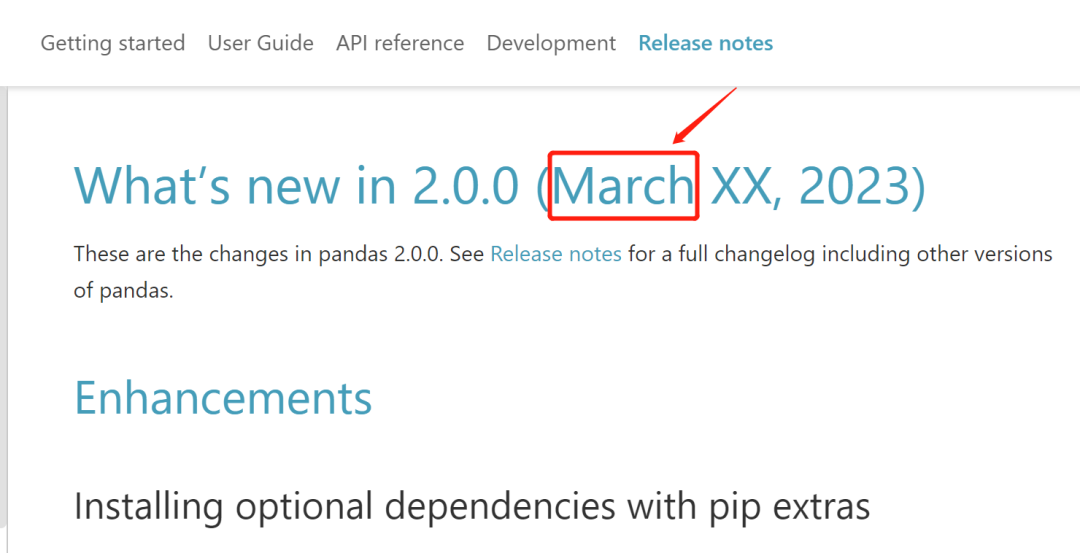呆鸟说:根据 Pandas 开发团队发布的消息,3月以后,Pandas 就要进入 2.x 时代了,Python 数据分析师快来入坑吧!

可配置选项,mode.dtype_backend 返回 pyarrow 数据类型
使用 pip 安装可选的支持库
Index 支持 Numpy 的 numeric 数据类型
使用 Copy_on_write(写入时复制)机制,提高写入性能
具体说明如下:
Pandas 2.x 最大的变化是加入了对 Apache Arrow 的支持。首先介绍一下什么是 Arrow。
Arrow 是 Apache 软件基金会支持的内存分析开发平台,它可以快速处理和移动大规模数据,为数据的扁平化和分层制定了标准化的,与语言无关的列式内存格式,以便在硬件层面上进行更高效的数据分析操作。
pyarrow 是为 Python 社区提供的 Arrow 支持库,与 NumPy 和 Pandas 的集成度非常高,从 2.0 版开始,Pandas 专门加入了对 pyarrow 数据类型的支持。
使用 pyarrow,可以让 pandas 处理数据的数据操作更快,内存使用效率更高,尤其是在处理超大数据集时,其优势更明显。
以下内容是 Pandas 2.0 开发公告介绍的对 arrow 的支持说明。
Pandas 之前在 read_csv()、read_excel()、read_json()、read_sql()、to_numeric() 等函数中使用 use_nullable_dtypes 关键字参数,让这些函数可以自动转换 nullable 数据类型,为了简化操作,Pandas 新增了一个 nullable_dtypes 选项,允许在没有明确指定时,把关键字参数在全局范围内设为 True。启用该选项的方式如下:
pd.options.mode.nullable_dtypes = True
这个选项仅用于函数的 use_nullable_dtypes 关键字。
Pandas 还新增了一个全局配置项:mode.dtype_backend,用于连接上述 read_csv() 等函数中的 use_nullable_dtypes=True 参数,以选择 nullable 数据类型。
DataFrame.convert_dtypes() 和 Series.convert_dtypes() 两种方法也可以使用mode.dtype_backend 这个选项。
mode.dtype_backend 的默认值为 pandas,返回的是 Numpy 支持的 nullable 数据类型。但现在也可以设置为 pyarrow,返回 pyarrow 支持的 nullable 数据类型,即 ArrowDtype。
示例代码如下:
In [13]: import io
In [14]: data = io.StringIO("""a,b,c,d,e,f,g,h,i
....: 1,2.5,True,a,,,,,
....: 3,4.5,False,b,6,7.5,True,a,
....: """)
....:
In [15]: with pd.option_context("mode.dtype_backend", "pandas"):
....: df = pd.read_csv(data, use_nullable_dtypes=True)
....:
In [16]: df.dtypes
Out[16]:
a Int64
b Float64
c boolean
d string[python]
e Int64
f Float64
g boolean
h string[python]
i Int64
dtype: object
In [17]: data.seek(0)
Out[17]: 0
# 主要看下面这行代码
In [18]: with pd.option_context("mode.dtype_backend", "pyarrow"):
....: df_pyarrow = pd.read_csv(data, use_nullable_dtypes=True, engine="pyarrow")
....:
In [19]: df_pyarrow.dtypes
Out[19]:
a int64[pyarrow]
b double[pyarrow]
c bool[pyarrow]
d string[pyarrow]
e int64[pyarrow]
f double[pyarrow]
g bool[pyarrow]
h string[pyarrow]
i null[pyarrow]
dtype: object
使用 pip 安装 pandas 时,可以指定要安装的可选支持库。
pip install "pandas[performance, aws]>=2.0.0"
Index 支持 Numpy 的 numeric 数据类型
Pandas 2.0 开始,可以在 Index 中使用更多的 numpy 数据类型。Pandas 之前只能使用 int64、 uint64 和 float64 等数据类型,从 2.0 开始,Pandas 支持所有 numpy 的 numeric 数据,如 int8、int16、int32、int64、uint8、uint16、uint32、uint64、float32、float64 等。
示例代码如下:
In [1]: pd.Index([1, 2, 3], dtype=np.int8)
Out[1]: Index([1, 2, 3], dtype='int8')
In [2]: pd.Index([1, 2
, 3], dtype=np.uint16)
Out[2]: Index([1, 2, 3], dtype='uint16')
In [3]: pd.Index([1, 2, 3], dtype=np.float32)
Out[3]: Index([1.0, 2.0, 3.0], dtype='float32')
DataFrame.reset_index() / Series.reset_index()
DataFrame.set_index()
DataFrame.set_axis() / Series.set_axis()
DataFrame.set_flags() / Series.set_flags()
DataFrame.rename_axis() / Series.rename_axis()
DataFrame.reindex() / Series.reindex()
DataFrame.reindex_like() / Series.reindex_like()
DataFrame.assign()
DataFrame.drop()
DataFrame.dropna() / Series.dropna()
DataFrame.select_dtypes()
DataFrame.align() / Series.align()
Series.to_frame()
DataFrame.rename() / Series.rename()
DataFrame.add_prefix() / Series.add_prefix()
DataFrame.add_suffix() / Series.add_suffix()
DataFrame.drop_duplicates() / Series.drop_duplicates()
DataFrame.droplevel() / Series.droplevel()
DataFrame.reorder_levels() / Series.reorder_levels()
DataFrame.between_time() / Series.between_time()
DataFrame.filter() / Series.filter()
DataFrame.head() / Series.head()
DataFrame.tail() / Series.tail()
DataFrame.isetitem()
DataFrame.pipe() / Series.pipe()
DataFrame.pop() / Series.pop()
DataFrame.replace() / Series.replace()
DataFrame.shift() / Series.shift()
DataFrame.sort_index() / Series.sort_index()
DataFrame.sort_values() / Series.sort_values()
DataFrame.squeeze() / Series.squeeze()
DataFrame.swapaxes()
DataFrame.swaplevel() / Series.swaplevel()
DataFrame.take() / Series.take()
DataFrame.to_timestamp() / Series.to_timestamp()
DataFrame.to_period() / Series.to_period()
DataFrame.truncate()
DataFrame.iterrows()
DataFrame.tz_convert() / Series.tz_localize()
DataFrame.fillna() / Series.fillna()
DataFrame.interpolate() / Series.interpolate()
DataFrame.ffill() / Series.ffill()
DataFrame.bfill() / Series.bfill()
DataFrame.where() / Series.where()
DataFrame.infer_objects() / Series.infer_objects()
DataFrame.astype() / Series.astype()
DataFrame.convert_dtypes() / Series.convert_dtypes()
concat()
以 Series 的形式处理 DataFrame 的单个列(例如,df["col"])时,每次构建都返回一个新对象,启用 Copy-on-Write 时,不再多次返回相同的 Series 对象。
使用已有的 Series 构建 Series,且默认选项为 copy=False 时,Series 构造函数将使用惰性复制机制,即推迟复制,直到发生数据修改时才真正复制。
使用已有的 DataFrame 构建 DataFrame,且默认选项为 copy=False 时,DataFrame 构造函数也使用惰性复制机制。
使用 Series 字典构建 DataFrame,且默认选项为 copy=False 时,也使用惰性复制机制。
启用 Copy-on-Write 时,使用链式赋值设置值(例如,df["a"][1:3] = 0)将引发异常。在此模式下,链式赋值不能正常运行。
DataFrame.replace() 在 inplace=True 时,使用 Copy-on-Write。
DataFrame.transpose() 使用 Copy-on-Write。
算术运算,如, ser *= 2 也支持 Copy-on-Write。
启用本选项的方式如下:
# 方式一
pd.set_option("mode.copy_on_write", True)
# 方式二
pd.options.mode.copy_on_write = True
# 局部启用的方式
with pd.option_context("mode.copy_on_write", True):
...
机器学习交流qq群955171419,加入微信群请扫码